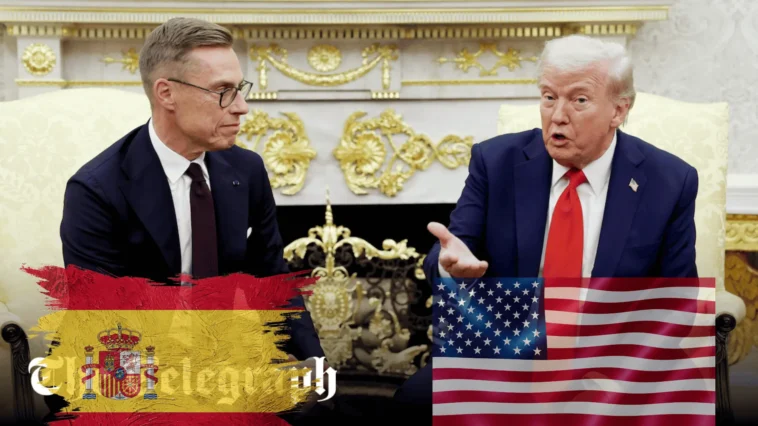President Donald Trump escalated tensions with Spain by suggesting NATO should expel the country over its refusal to meet the alliance’s new 5% GDP defense spending target, marking a significant diplomatic confrontation within the Western military alliance.
Trump Calls Spain NATO’s Biggest “Laggard”
During an Oval Office meeting with Finnish President Alexander Stubb on Thursday, Trump directly criticized Spain’s defense spending commitments, calling the country a “laggard” within NATO’s 32-member alliance.
“Maybe you should throw them out of NATO, frankly,” Trump stated, escalating his months-long dispute with Madrid over military expenditure requirements.
The Trump Spain NATO controversy centers on Spain’s rejection of the alliance’s new spending framework agreed upon at The Hague summit in June 2025. While 31 NATO members committed to the enhanced defense spending targets, Spain secured a last-minute exemption under Prime Minister Pedro Sánchez’s leadership.
Spain NATO Defense Spending Dispute Explained
Current Spanish Military Budget Reality
Spain currently allocates just 1.28% of GDP to defense, making it NATO’s lowest spender among all member nations. This figure falls significantly short of both NATO’s traditional 2% target and the new 5% requirement established in 2025.
The NATO 5 percent GDP target breaks down into specific categories designed to modernize alliance capabilities :
- 3.5% for core military expenditures
- 1.5% for defense-related infrastructure, cybersecurity, and resilience measures
Spain’s Position on NATO Spending Requirements
Spanish Prime Minister Pedro Sánchez has consistently argued, that the Spain NATO spending increase to 5% would be “incompatible with our welfare state and worldview”. Instead, Spain committed to reaching only 2.1% of GDP by 2025, maintaining its focus on social spending priorities.
Spanish Defense Minister Margarita Robles responded to Trump’s expulsion threats by emphasizing Spain’s loyalty: “Spain is one of the committed and loyal NATO allies”.
Madrid argues that its contributions extend beyond financial metrics through active military deployments across multiple NATO missions.
NATO Alliance Unity Under Pressure
Record Defense Spending Surge Across NATO
The NATO defense spending 2025 projections show alliance-wide military budgets surging 15.9% to a record $1.6 trillion, driven primarily by Russian aggression concerns following Moscow’s invasion of Ukraine.
All 31 NATO members with armed forces are expected to meet the longstanding 2% benchmark in 2025, up from just 10 members in 2023.
Spain’s Military Contributions Despite Budget Constraints
Despite lower Spain defense budget allocations, the country maintains active participation in NATO operations across Europe :
- Military deployments in Latvia, Slovakia, Romania, Bulgaria, and Turkey
- Ukraine support through military and humanitarian aid since Russia’s invasion
- NATO membership since 1982 with full integration into alliance command structure
Finland Example Highlights NATO Expansion Success
Trump’s choice to criticize Spain during his meeting with Finnish President Alexander Stubb was strategically significant. Finland joined NATO in 2023 following Russia’s invasion of Ukraine and now exceeds the 2% spending threshold, exemplifying the alliance expansion and increased defense commitments Trump champions.
Implications for NATO Future
Diplomatic Consequences of Trump Spain NATO Tensions
The NATO expulsion threat represents unprecedented public criticism of an alliance member over spending disputes. Defense experts warn that such confrontations could undermine alliance unity at a critical time when NATO faces its largest military buildup since the Cold War.
Broader NATO Spending Target Challenges
The ambitious NATO 5% GDP spending goal poses significant fiscal challenges for European members already managing substantial debt burdens. Political resistance to dramatic military spending increases exists across multiple member nations, not just Spain.
NATO Secretary General Mark Rutte structured the 5% target to address both traditional military needs and emerging security challenges including cybersecurity and infrastructure resilience. However, implementation by 2035 requires extraordinary financial mobilization on a scale not seen since the Cold War.
This Trump NATO Spain controversy highlights fundamental tensions between American expectations for European defense spending and domestic political realities facing alliance members balancing military commitments with social welfare priorities.





GIPHY App Key not set. Please check settings